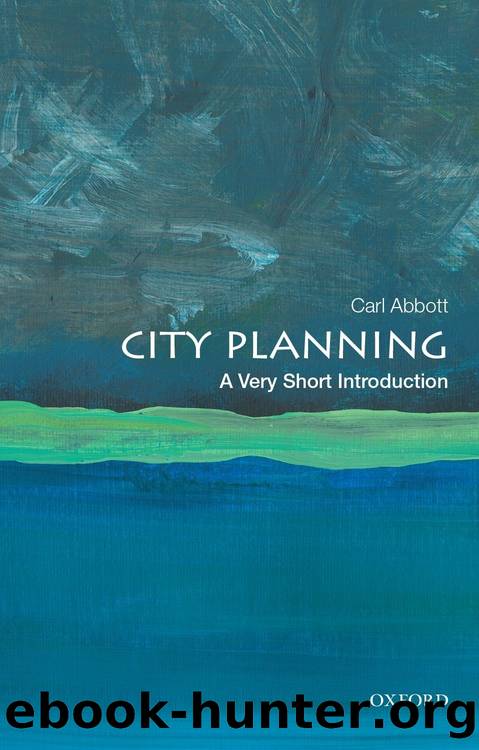City Planning: A Very Short Introduction by Carl Abbott

Author:Carl Abbott [Abbott, Carl]
Language: eng
Format: epub, azw3
ISBN: 9780190944360
Google: lpr5DwAAQBAJ
Amazon: 019094434X
Publisher: Oxford University Press
Published: 2020-08-31T23:00:00+00:00
Alternative voices
In 1967, members of the American Institute of Planners (AIP, a predecessor of the American Planning Association) argued vehemently over the definition of planning. Since 1938, the AIP constitution had defined the field as âthe planning of the unified development of urban communities and their environs and of states, regions and the nation, as expressed through determination of the comprehensive arrangement of land uses and land occupancy and the regulation thereof.â Now, after emotional debates, the AIP dropped the final phrase and added social and economic planning to its definition.
Both the public and practitioners had tended to view the design professions as primary, and their approach had dominated city-planning education in the first decades of the twentieth century. Architects like Le Corbusier and Frank Lloyd Wright dominated public discussion of urban futures. In the 1950s, transportation planners who began to work with large data sets reinvigorated the engineeringâplanning nexus that had contributed to the fieldâs origins in the previous century. At the same time, however, planners were turning toward the social sciences and urban studies. The key document was Harvey Perloffâs 1957 book The Education of City Planners. Perloff was then the head of the planning program at the University of Chicago, the center of systematic research on urban society. He called for a planning curriculum that emphasized systematic knowledge of cities as functioning systems that are shaped by and shape social and technological trends. He believed that planners needed to understand basic principles of socioeconomic change, develop hypotheses, and test these ideas with research. In short, planning educators should aim to train applied social scientists first, designers second.
The changing political dynamics of the 1960s and 1970s brought new emphasis on citizen and community input into planning decisions. The Community Action program (1965) and the Model Cities program (1967) of President Lyndon Johnsonâs War on Poverty required citizen consultation and participation in neighborhood planning decisions. The Community Development Block Grant program, begun in 1974, extended the participatory mandate. The result is a constant tension, sometimes creative and sometimes paralyzing, between community activists and professionally trained planners and consultants assigned to work on community plans. Sherry Arnstein, a policy specialist with the US Department of Housing and Urban Development, in 1969 described a âladder of citizen participationâ that recognizes the frequent gap between pro forma citizen consultation and substantial citizen influence on planning decisions. The ladder arrays participation approaches from manipulation and therapy through consultation and partnership to delegation and citizen control.
When the AIP changed its mission statement, the profession was absorbing activist planner Paul Davidoffâs influential argument for âadvocacy planning.â Davidoff recognized that American planning had originated and developed with the support of local civic leaders and with a business-oriented agenda of facilitating efficient metropolitan growth. He also recognized that unequal access to expertise and information is a basic source of unequal power. He argued forcefully that planners should engage more directly in the struggle for equal civil and economic rights by using their expertise to work on behalf of disadvantaged segments of society.
Download
City Planning: A Very Short Introduction by Carl Abbott.azw3
This site does not store any files on its server. We only index and link to content provided by other sites. Please contact the content providers to delete copyright contents if any and email us, we'll remove relevant links or contents immediately.
Zero to IPO: Over $1 Trillion of Actionable Advice from the World's Most Successful Entrepreneurs by Frederic Kerrest(4069)
Machine Learning at Scale with H2O by Gregory Keys | David Whiting(3648)
Harry Potter and the Goblet Of Fire by J.K. Rowling(3612)
Never by Ken Follett(3537)
Ogilvy on Advertising by David Ogilvy(3345)
Shadow of Night by Deborah Harkness(3178)
The Man Who Died Twice by Richard Osman(2812)
Book of Life by Deborah Harkness(2723)
My Brilliant Friend by Elena Ferrante(2705)
How Proust Can Change Your Life by Alain De Botton(2617)
0041152001443424520 .pdf by Unknown(2603)
Will by Will Smith(2584)
The Tipping Point by Malcolm Gladwell(2563)
How to Pay Zero Taxes, 2018 by Jeff A. Schnepper(2503)
Purple Hibiscus by Chimamanda Ngozi Adichie(2498)
Hooked: A Dark, Contemporary Romance (Never After Series) by Emily McIntire(2426)
Rationality by Steven Pinker(2153)
Borders by unknow(2119)
Daughter of Smoke and Bone by Laini Taylor(2083)
